Motorola Moto G Review
by Brian Klug on December 18, 2013 2:00 PM EST- Posted in
- Smartphones
- Motorola
- Mobile
- *VA
- Cortex A7
- snapdragon 400
- Moto G
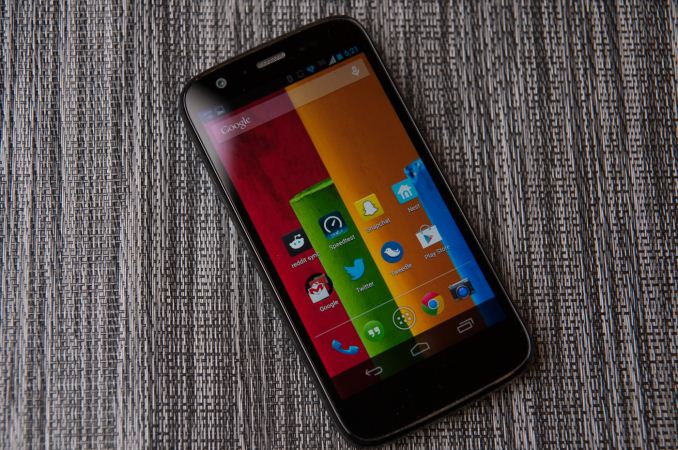
I like what the new Motorola is doing. It seems like an eternity ago, but I remember when phone launches with Motorola meant a variety of variants all with their own idiosyncrasies. Since re-launching itself, Motorola has launched just two new lines of device – the higher end Moto X, and its mass-market cousin, the Moto G which we’re taking a look at. That’s a bit of a simplification, as Motorola is still selling five Droid-branded handsets, but it’s a huge consolidation that’s much easier to follow.
The Moto G’s goal is pretty simple – to deliver an affordable smartphone experience that doesn’t make any sacrifices in something close to the Moto X’s form factor. It’s an ambitious goal that goes right after some of the largest growth segments for smartphones internationally. There’s a ton of competition at the top, it’s somewhere in the middle that’s arguably more interesting right now.
G is a popular character right now, LG was arguably first to lay claim to it with its Optimus G, G Pro, G2, and now G Flex brands, so it’s kind of interesting to see Motorola also lay claim to G with the Moto G. Absent any guidance what G actually stands for, I’m going to take a nod from lens reviewer Ken Rockwell and say that G stands for “Gelded” since the Moto G is really a pared down Moto X, but I wouldn’t attach any real negative connotation to the word. The form factor is largely the same, where the Moto G moves down a notch versus the X is in its camera, display size and tech, cellular connectivity, size (it’s slightly bigger), and of course the lack of active display or always on voice activation features. Like any product, it’s just a different set of tradeoffs, this time more optimized for cost.
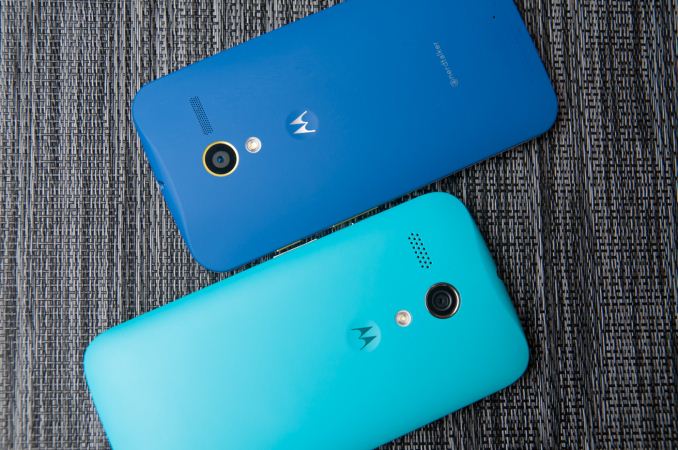
My T-Mobile Motomaker Moto X (top), Moto G with turquoise back shell
Before I started working on the Moto G, I switched back to the Moto X for a while to refresh my comparison point, right after it got the 4.4 update. Motorola let me build a blue with yellow accents Moto X from Motomaker since I recently switched to T-Mobile and my previous device was locked to AT&T. The comparison point helped me really feel out the physical differences between the Moto X and Moto G. You can tell that the Moto G is slightly thicker almost immediately, the changes in width, height, and mass don’t really stick out as much. I can’t put my finger on it but the curve of the G seems slightly less pronounced as well, although the G is still comfortable to hold. I won’t bore you any further, but the dimensional differences really aren’t that noticeable between the two, I don’t feel like the Moto G’s in hand feel is a regression at all versus the excellent Moto X.
| Moto X | Moto G | |
| SoC |
Qualcomm Snapdragon S4 Pro (MSM8960Pro) 2x Krait 300 at 1.7 GHz Adreno 320 at 400 MHz Motorola X8 System (SoC+NLP Processor+Contextual Processor) |
Qualcomm Snapdragon 400 (MSM8x26) 4x ARM Cortex A7 at 1.2 GHz Adreno 305 at 450 MHz |
| Display | 4.7-inch AMOLED (RGB) 1280x720 | 4.5-inch LCD (RGB) 1280x720 |
| RAM | 2GB LPDDR2 | 1 GB LPDDR2 |
| WiFi | 802.11a/b/g/n/ac, BT 4.0 | 802.11b/g/n, BT 4.0 |
| Storage | 16 GB standard, 32 GB online, 2 years 50 GB Google Drive | 8/16 GB, 2 years 50 GB Google Drive |
| I/O | microUSB 2.0, 3.5mm headphone, NFC, Miracast | microUSB 2.0, 3.5mm headphone |
| OS | Android 4.4 | Android 4.3, 4.4 Early 2014 |
| Battery | 2200 mAh, 3.8V, 8.36 Whr | 2070 mAh, 3.8V, 7.9 Whr |
| Size / Mass | 65.3 x 129.3 x 5.6-10.4 mm, 130 grams | 65.9 x 129.9 x 6.0-11.6 mm, 143 grams |
| Camera |
10 MP Clear Pixel (RGBC) with 1.4µm pixels Rear Facing 2 MP 1080p Front Facing |
5 MP w/AF, LED Flash 1.3 MP front facing |
| Price | $199 (16 GB), $249 (32 GB) on 2 year contract | $179 (8 GB), $199 (16 GB) no contract |
If you’ve held the Moto X, the Moto G is immediately familiar. For those that haven’t, the two share what’s probably the best balance of size and form factor among Android handsets right now – Moto G is just a bit thicker around the waist.
On the front the Moto G eschews the “magic” fused glass-plastic top layer. For those unaware, one of the standout features of the Moto X was this seamless (well, relatively seamless) transition from glass to plastic along the edge, which really did make it more comfortable to use. Moto G uses the more pragmatic lip and sunken glass approach, and the sample I was provided has a bit of a gap between the two where dust can gather and show. Not a big deal but worth noting as one of the few visible differences. The Moto G still does have some nice lips that prop the display up so you can lay it display-first on a flat surface without worrying about scratching the display.
The Moto G uses the same button and port placement as the Moto X, which I won’t go over. The buttons feel nice and solid as well, not cheap and flimsy. The speakerphone grille moves to the opposite side, but camera and flash positions remain unchanged. The motorola logo and accompanying dimple also don’t go away.
Impressively, Moto G also doesn’t eschew dual microphones for in-call background noise cancelation. There’s a primary microphone at the bottom, and secondary up top. Moto X had a bottom front, bottom back, top side arrangement, so technically Moto G has one fewer microphone, but having dual mic noise suppression is a noteworthy feature at this price point.
The most dramatic change between the two of course is the removable back door, which doesn’t work so much as a door for the battery as it does gate access to the microSIM slot and add an opportunity for adding a touch of customization with a colored or flip shell. As an aside, it’s odd to me that the Moto X embraced nanoSIM (4FF) yet the Moto G that launches after it goes with microSIM (3FF). It’s possible some of the operators or markets Motorola has in mind for the Moto G haven’t yet made nanoSIMs readily available. There’s a big sticker on the back noting that the battery isn’t replaceable, I’m reminded of the Droid 4 which also included a removable back and a big sticker, but no removable battery.
Motorola sent a turquoise colored snap-on shell in addition to a blue flip shell to check out on the Moto G. By default the phone comes with a black shell, but there are six different color shells you can choose from, in those two (flip and non-flip) varieties. I appreciate how much even something like this helps differentiate the Moto G versus competition that comes in at best maybe two or three colors. The materials, fit, and finish on the two snap covers I was sent seem excellent. I have no complaints, there’s no creaks or gaps to speak of. Shells run $14.99, flip shells cost a twenty bucks more at $34.99.
The flip cover nails it though, there’s a magnet inside to both keep the cover shut and in place when closed, and another ostensibly for signaling open and closed status – Moto G turns on automatically when opened, and shuts off when closed. Those two features should be requisite for anyone even thinking of bundling a flip cover as a first party accessory at this point, and I’m impressed to see them on this device at that price point.
Inside the relatively small Moto G box you don’t get much in the way of extra stuff. There’s no bundled USB wall charger or pack-in headphones, just a USB cable. I’m awash with USB chargers so I don’t mind OEMs saving the extra few dollars by not including an extra one, in the case of Moto G at least that savings seems to actually get passed on to the customer. I’ll talk about it in the charging section but Moto G seems well behaved with a variety of USB power sources, thankfully.
Moto G doesn’t try to push industrial design somewhere crazy, and obviously at the price point that it’s coming in at, it can’t really afford to. Solid execution which doesn’t deviate a lot from Moto X and good overall construction are the real highlights.


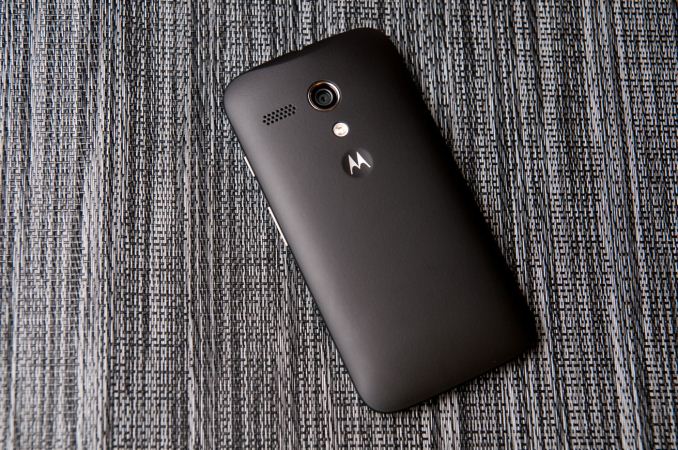
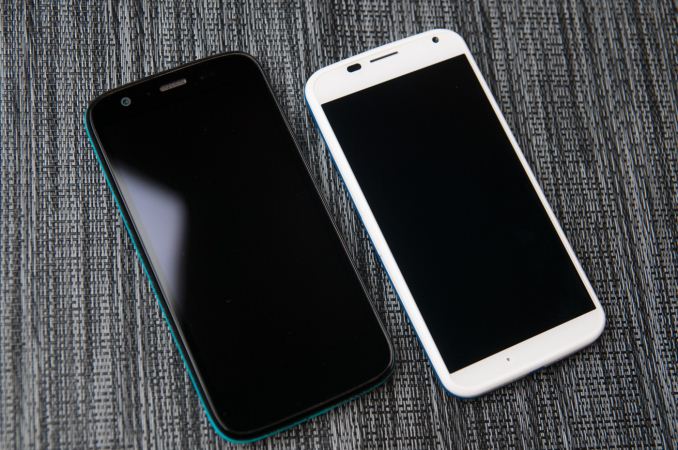






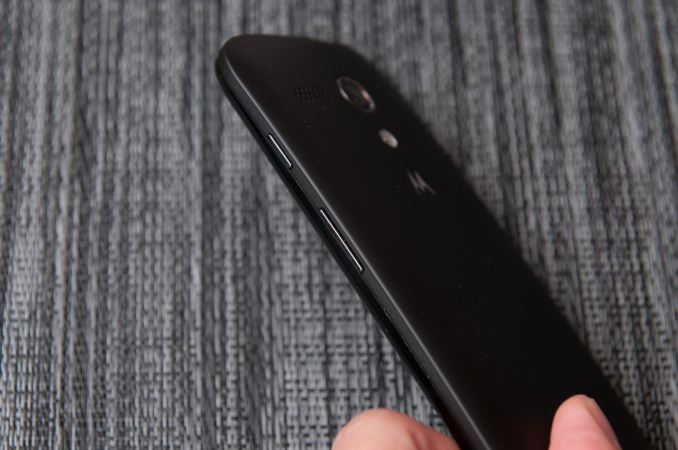
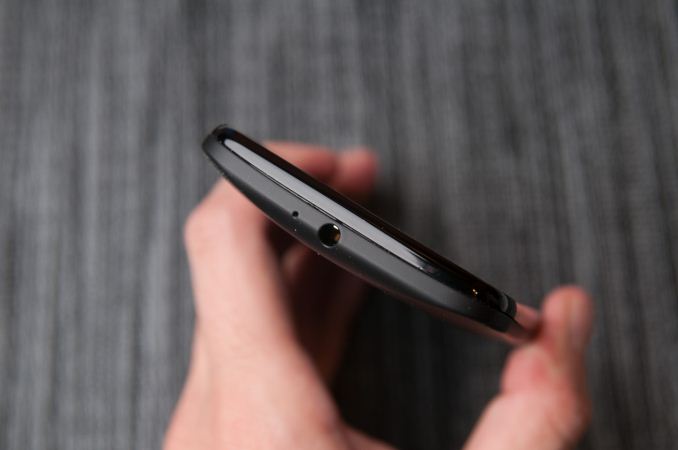
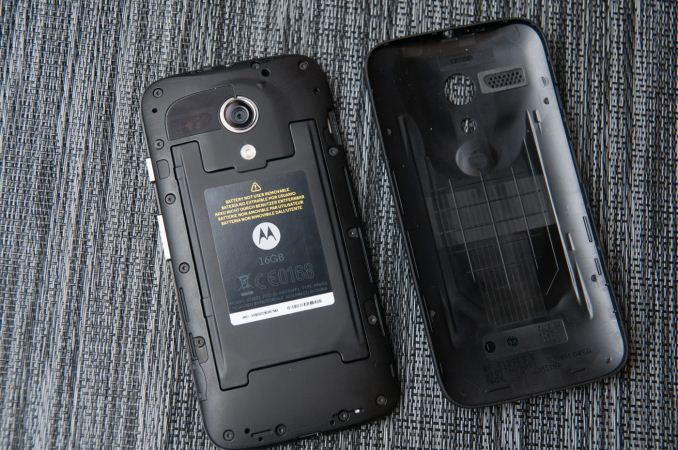
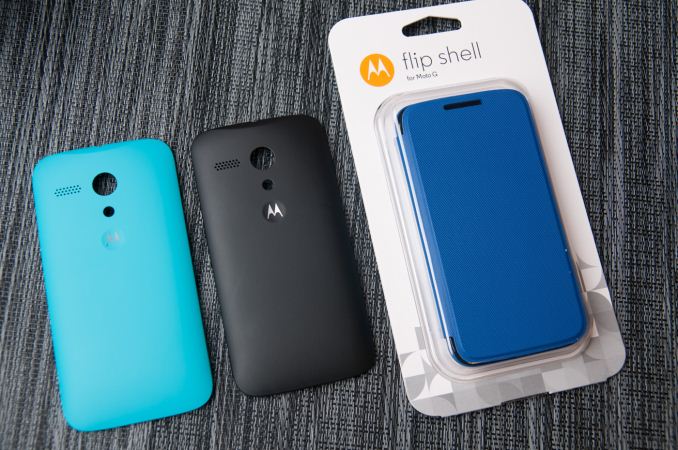









120 Comments
View All Comments
apertotes - Thursday, December 19, 2013 - link
No, I do not. There are two sides here. Some say Samsung sells because of marketing, some say Samsung sells because they understand better what the consumer wants (micro-sd, removable batteries, etc.). Neither side is backing their arguments with any proof at all.uhuznaa - Thursday, December 19, 2013 - link
Well, the fact remains that you can hardly view any review of a competing product on Youtube without a Samsung ad being forced down your throat before it. They must be spending a hell of a pile of money on that.apertotes - Thursday, December 19, 2013 - link
So? Is it less of a fact that Samsung high end devices keep a micro-sd slot and removable battery?Bob Todd - Friday, December 20, 2013 - link
Yes it is, for the simple undeniable truth that enthusiasts make up a tiny sliver of this market (just like is true for most markets). We (enthusiasts) are closer to a rounding error on their financial statements than an overwhelming majority. For every user who clamors for removable batteries or the ability to flash a custom kernel to overclock their phone, there are 95 others who just walk into the store and buy whatever cool phone they saw on TV, or whatever their friends use, or whatever the guy at the counter steered them toward. Samsung could bring the Galaxy S5 to market with sealed batteries and no expandable storage and it would still be the single best selling Android phone by an enormous margin. I have no idea why you are so hell-bent on convincing others, or deluding yourself, that the % of people that really care about these things (or read blogs like Anandtech clamoring for in-depth SOC analysis) make up more than a puddle vs. the ocean of people who DGAF.metayoshi - Friday, December 20, 2013 - link
The guy behind the counter is definitely a major factor, and I believe Samsung dedicates some of their money into that. I remember my sister was due for an upgrade from her Verzion Galaxy Nexus, and I convinced her to buy a G2 and even linked her the mini review from this site. She told me battery life and a good camera were priority, and to me, it was a no brainer.In she walks into the Verizon store, and boy was the guy trying hard to sell the GS4. I told her, the LG has essentially the same features as the GS4 down to the gimmicky camera features, but the camera quality (OIS), and the 3000 mAh battery is much better than what the GS4 will deliver. If I wasn't there, there is no doubt in my mind that my sister would have a GS4.
So yeah... for the people that just don't know what all of their options are, and they go to the phone salesmen for the "expert" advice, which makes up the majority of people, what they're really getting is the phone that the employees are getting paid the most money to sell, which, in my case, was definitely the GS4. After that experience, there is no doubt in my mind that Samsung is giving extra commission to employees who sell these Samsung phones.
shaduck007 - Saturday, January 4, 2014 - link
At Best Buy, I always ask the Intel specialist his opinion.apertotes - Monday, December 23, 2013 - link
That is simply not a fact. That is your poorly reasoned opinion. Facts are:1. Samsung invests a lot of money in advertising and marketing.
2. Samsung's phones have micro-sd and removable battery.
Unless you work as a high level Samsung employee, there is no way to know which of those facts affect sales in a more powerful way.
bhima - Monday, December 23, 2013 - link
iPhones have literally ZERO of those features listed in number 2. They sell by the truckload. Bob Todd is spot on and said it best, Anandtech readers/tech enthusiasts make up a rounding error in the financial statements of these companies.apertotes - Tuesday, December 24, 2013 - link
and that is why HTC did not sell that much. They can't compete on features with Samsung, they are competing with iPhones. And nobody can beat Apple in their own turf. At least Motorola is pricing the G way below.Now, Apple says a truckload of iphones without removable storage or batteries. That is completely true. But Apple is on a league of its own. Neither better nor worse. Simple different. Apple users do not care that much about raw power or features. Also, Starbucks, trendy, hipster, instagram.
boeush - Wednesday, December 18, 2013 - link
"3-4 GB of music" is about 1000 songs."In crappy 64 kbps bit rate, maybe. Personally, I don't do crappy when it comes to my music: all my stuff is ripped to CD-quality at a minimum, and lossless (FLAC) when possible. For instance a single anthology collection for a single band that I have currently on my phone, takes up nearly 10 GiB.